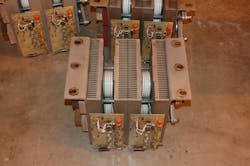Have you ever wondered how some piece of digital technology developed? Or, what led up to some power electronics we take for granted today? Or, why we call something by a name that doesn’t seem to make sense? I know I have, and I asked a lot of people I met over the years to explain things to me. The staff of this center of excellence thought it might be interesting to share some of these tidbits from time to time. One question I have been asked by friends and clients continuously over the years is, why do we call it a valve? For that matter, why do we call it a thyristor instead of silicon-controlled-rectifier (SCR)? This is a very basic piece of today’s power electronics and it could use a little clarification.
The thyristor valve is an important component used in FACTS controllers and line commutated HVDC converters all the time, but it seems strange. Mechanical engineers are always using water pipes to try to explain how electricity works. Did some mechanical engineer sneak the name valve into power electronics? That would be a good urban myth, but it’s not true. The term thyristor has a very logical etymology. Many years ago, I was talking to a colleague, Ed Owen, who was the GE historian at the time and I asked him if he knew why we used the terms valve and thyristor. He told me the following story. The mercury-arc valve was the basis of dc technology back in the day. Engineers in Europe followed the English convention of referring to tubes (vacuum tubes used in early radios) as valves, so the mercury-arc valve name became common.
In 1921, some GE engineers modified the mercury-arc valve with a gas filled tube they called a thyratron. The word thyratron was formed from the Greek words thyra meaning gate and tron meaning tube. Then in 1957 another group of GE engineers developed the SCR (more on that in a future column), which many compared to a transistor capable of handling high-power. So, it was natural that someone combined the words thyratron and transistor to form our favored term thyristor. The name became so popular that in 1963 the IEEE (Institute of Electrical and Electronic Engineers adopted thyristor as the official name.
About the Author
Gene Wolf
Technical Editor
Gene Wolf has been designing and building substations and other high technology facilities for over 32 years. He received his BSEE from Wichita State University. He received his MSEE from New Mexico State University. He is a registered professional engineer in the states of California and New Mexico. He started his career as a substation engineer for Kansas Gas and Electric, retired as the Principal Engineer of Stations for Public Service Company of New Mexico recently, and founded Lone Wolf Engineering, LLC an engineering consulting company.
Gene is widely recognized as a technical leader in the electric power industry. Gene is a fellow of the IEEE. He is the former Chairman of the IEEE PES T&D Committee. He has held the position of the Chairman of the HVDC & FACTS Subcommittee and membership in many T&D working groups. Gene is also active in renewable energy. He sponsored the formation of the “Integration of Renewable Energy into the Transmission & Distribution Grids” subcommittee and the “Intelligent Grid Transmission and Distribution” subcommittee within the Transmission and Distribution committee.
